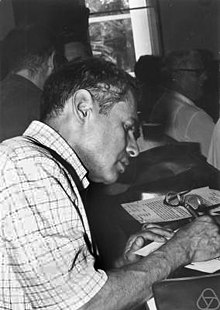Irving Segal
| Irving Segal | |
|---|---|

Irving Segal in Nice, 1970
|
|
| Born |
September 13, 1918 The Bronx, New York |
| Died | December 24, 1998 (aged 80) Lexington, Massachusetts |
| Nationality | American |
| Fields | Mathematics |
| Institutions |
MIT University of Chicago |
| Alma mater | Yale University |
| Doctoral advisor | Einar Hille |
| Doctoral students |
John C. Baez Lester Dubins Henry Dye Jacob Feldman Roe Goodman Leonard Gross Bertram Kostant Ray Kunze Richard Lavine Ernest Michael J. Edward Nelson Niels Poulsen Isadore Singer Walter Strauss |
Irving Ezra Segal (September 13, 1918 – August 30, 1998) was an American mathematician known for work on theoretical quantum mechanics. He shares credit for what is often referred to as the Segal–Shale–Weil representation.
Early in his career Segal became known for his developments in quantum field theory and in functional and harmonic analysis, in particular his innovation of the algebraic axioms known as C*-algebra.
Irving Ezra Segal was born in the Bronx in 1918 to Jewish parents. He attended school in Trenton. In 1934 was admitted to Princeton University at the age of 16. He was elected to Phi Beta Kappa, completed his undergraduate studies in just three years time, graduated with highest honors with a Bachelors in 1937, and was awarded the George B. Covington Prize in Mathematics. He was then admitted to Yale, and in another three years time had completed his doctorate, receiving his PhD in 1940. Segal taught at Harvard University, then he joined the Institute for Advanced Study in Princeton on a Guggenheim Memorial Fellowship, working from 1941–43 with Albert Einstein and Von Neumann. During World War II Segal served in the U.S. Army conducting research in ballistics at the Aberdeen Proving Ground in Maryland. He joined the mathematics department at the University of Chicago in 1948 where he served until 1960. In 1960 he joined the mathematics department at M.I.T. where he remained as a professor until his death in 1998. He won three Guggenheim Fellowships, in 1947, 1951 and 1967, and received the Humboldt Award in 1981. He was an Invited Speaker of the ICM in 1966 in Moscow and in 1970 in Nice. He was elected to the National Academy of Sciences in 1973.
...
Wikipedia
